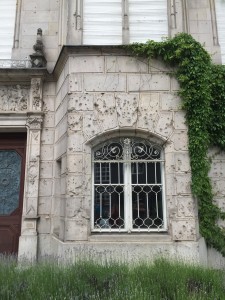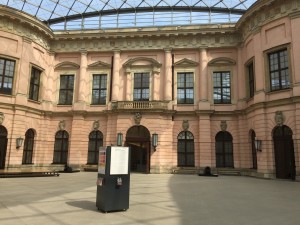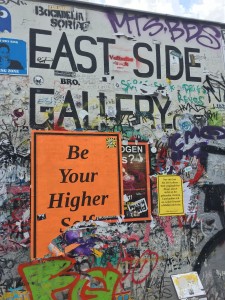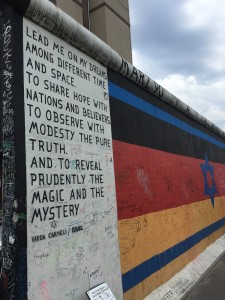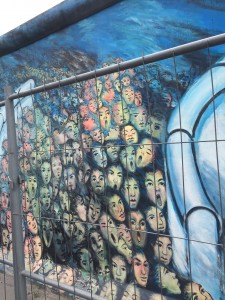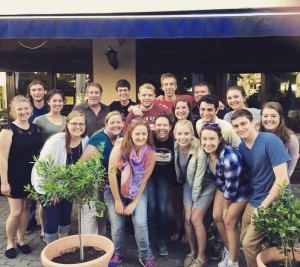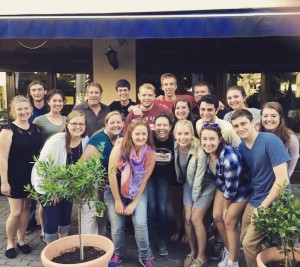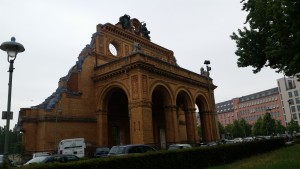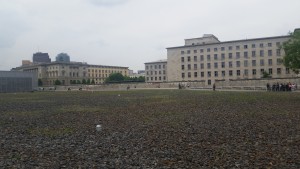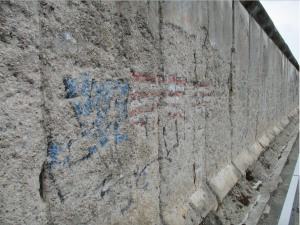
The remains of Berlin Anhalter Bahnhof – still standing today as a symbol of German defeat in World War II
Berlin was the third of the great national capitals our group visited and the final stop on our journey through Europe. After a seven-hour bus ride from Poland, our tired group arrived in the city. Having experienced the greatness of both London and Paris, I had high expectations for Berlin. Initially, I was somewhat disappointed
I was struck by the relative new-ness of everything, as well as how dingy it seemed. Gone were the old buildings and grand architecture seen in London and Paris. More than any other city I’d seen thus far, Berlin felt more like an American city than a European one. Despite my relative disappointment, the city quickly grew on me.

The German Finance Ministry Building – an example of Nazi architecture – next to a remaining portion of the Berlin Wall. The bricks at the bottom of the frame are the remains of the old Gestapo headquarters
One of the aspects of Berlin that struck me were the many remnants of the city’s past I came across, despite the city’s “new” feel – specifically, remnants from the Nazi-era, as well as the Cold War. The twentieth century was not kind to Berlin. Much of the city was destroyed at the end of World War II in allied bombing raids and in the climactic Battle for Berlin, which resulted in the final defeat of Nazi Germany and the end of the war in Europe. Some of the remains of the old Gestapo Headquarters have been preserved, and today, a museum exists on top of the site, preserving the memory of terror, persecution, and genocide that defined the Nazi-era in Germany. The former German Ministry of Aviation building (constructed in 1936) is one of the few buildings left from the Nazi-era. I was surprised to learn that this building is still used by the German government today, housing the German Finance Ministry. Smaller sites also remain, such as the Bendlerblock, which housed the General Army Offices during World War II. Its courtyard served as the execution site of some of the July 20th Plotters who attempted to assassinate Hitler in 1944, and today, the complex is a museum dedicated to the memory of German “resistance” against the Nazi regime.
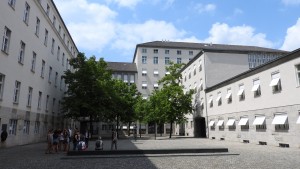
The courtyard of the Bendlerblock – the execution site of some of the July 20th Plotters in 1944, including Claus von Stauffenberg. The final scenes of the 2008 film Valkyrie were filmed here
In other cities, these reminders of a hideous past might be swept under the rug, but in Berlin, they have instead been embraced as learning tools for future generations of Germans. The city has made an effort to come to terms with its Nazi past. Where direct sites of Nazi history are lacking, Berlin has attempted to create as many sites of remembrance as possible. The Holocaust is the most shameful and embarrassing aspect of German history that, for decades, many Germans tried to ignore and move on from. Despite this fact, memorials of the genocide have been constructed all over the city. The Tiergarten houses a number of memorials to the victims of Nazism (Roma, Sinti, the disabled and mentally handicapped, homosexuals, …). Most impressive, however, is the Memorial to the Murdered Jews of Europe. Taking up an entire city block, the memorial is right at the heart of the city, next to the Brandenburg Gate, the American Embassy, and the Reichstag Building. There could be no stronger effort to remember a humiliating past than a massive Holocaust memorial taking up such major real estate in the German capital.
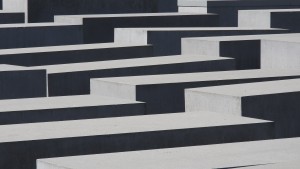
A portion of the Memorial to the Murdered Jews of Europe
This effort at coming to terms with the past is also reflected in the historical museum exhibits I went through in Berlin. One of the most common excuses made by Germans ever since the end of the war is that the Nazis lacked popular support, and that the crimes committed under the Nazis (both before and during the war) were committed only by dedicated party members. Such narratives make it all too easy for Germans to place the blame on a defined group (the Nazis) while glossing over their own complicity in the atrocities committed. The museums in Berlin, however, tackle the matter of German complicity directly. Time and again, when addressing the crimes of the Nazi-era, these museums address the perpetrators as “the Germans” rather than “the Nazis.”
One placard in particular at the German Historical Museum caught my attention, concerning the role of the German military in the Holocaust. The “Final Solution” was primarily an operation conducted by the Waffen-SS, the military-wing of the Nazi Party. Since the SS was separate from the German military (the Wehrmacht), many Germans have used this fact to argue that ordinary Germans in the Wehrmacht had no role in the Holocaust, and therefore, had no responsibility in the crimes of the Nazi-era. Again, this narrative goes against reality; the Wehrmacht took part in a tremendous amount of war crimes, including the massacre of Poles, Jews, and Soviet POWs on the Eastern Front. Avoiding the common excuse, the museum exhibit explicitly mentioned the role of the Wehrmacht in perpetuating the Holocaust, therefore wiping away any defense made for the general German population.

The Memorial to the Murdered Jews of Europe is located at the heart of the city. Next to the memorial in this photo is the United States Embassy
Unlike at the end of World War I, the German people truly felt defeat at the end of World War II. Berlin was divided by the victorious powers at war’s end and was split into East and West by the Berlin Wall in 1961. Despite the fall of the wall in 1989 and 1990, its remnants are everywhere throughout the city. The standing sections of the wall today stand not only as a symbol of the Cold War, but, more importantly, as a symbol of defeat. Germany bears a large responsibility for the suffering of the two World Wars in Europe. The German people can’t ignore this, especially in a city like Berlin, where symbols of defeat (such as the Berlin Wall) remain. Just a block away from our hotel was another symbol of German defeat – the remains of Berlin Anhalter Bahnhof – a great railway station destroyed by bombing during World War II.

Bricked paths run through the streets of Berlin, marking where the Berlin Wall once stood
Berlin is a city that has both accepted and learned from its past, precisely because of this defeat. Unlike the victorious Allies, the Germans were forced to question their own past and their own sense of nationalism – to question their role in the widespread misery that accompanied the two World Wars and the Cold War. I couldn’t help but compare Berlin with the other cities I have seen – London, Paris, and Kraków. The British, the French, and the Poles were on the winning side of the war, and have never been forced to question their own national histories (history is written by the victors, right?). As I mentioned in a previous post, the British still celebrate and glorify their former colonial empire, despite its legacy of oppression. Likewise, the French, on the victorious side at the end of the war, were free to rewrite their own national history, lionizing Charles de Gaulle, the Free French, and the French resistance – all despite the fact that a majority of the French population accommodated their German occupiers and that thousands of Frenchmen actively aided in the Holocaust.

The glass dome of the newly renovated Reichstag Building, meant to symbolize democracy and political transparency
While London and Paris look back to a mythical national past, Berlin has tried to come to terms with its own harsh reality, and instead, looks forward to the future. The Reichstag Building, renovated after German reunification in 1990, reflects this outlook: avoiding the grandiose architecture of other national capitals, the building embraces modernity and democracy. Its glass dome stands as a symbol of political transparency. This outlook is also reflected in present day politics. In Britain, France, and Poland, nationalist movements are on the rise (UKIP in Britain, the National Front in France, the Law and Justice Party in Poland, …). Germany, however, remains one of the few countries without a resurgent nationalist movement. In the wake of the Syrian Refugee Crisis last year, Germany accepted hundreds of thousands of refugees into its borders, a move derided by nationalist movements in most other European countries.
Berlin is a city born of defeat, a defeat which, paradoxically I think, has made it stronger – prepared to accept its terrible past and to move forward. On a section of the Wall in East Berlin is a quote from the Austrian Poet, Erich Fried: “he who wants the world to remain as it is doesn’t want it to remain at all.”

“He who wants the world to remain as it is doesn’t want it to remain at all.”




